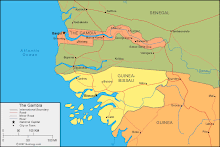First off, sorry for the long, long delay in posting. It's just been hectic, and posting a blog takes some dedicated time, even short ones like mine.



Lately, I've been working with the community forestry association on a mangrove reforestation project in Western Region. It's been fun, exhausting... the usual in The Gambia. But mostly it's been exciting for me to see the association finally able to take on a project with full funding support, so they can really make some effective progress and not have to worry about the usual hassles of no money to buy lunch, no money to buy phone credit, no money to pay transport. Suddenly, here we are with plenty of funding thanks to the WWF and boy are we working it. In two weeks, we planted more than 37,000 mangroves over 15 hectares in 5 villages. Here's how it works:
Our first job is to go collect little mangrove seedlings. If you've never seen a mangrove seedling before, it's pretty cool and unusual. Most trees make seeds that fall to the ground and a little tree germinates and grows. Mangroves have flowers that send out shoots that get longer and longer until they eventually touch the ground and become a root. And a new tree is born. So our job is to go to an area with lots of mangroves that are producing seedlings, and snap off the seedlings to take somewhere else.

A group of about 13 of us went to the mighty River Gambia and took a boat out to collect as many seedlings as we could. We had several strategies. The first was to get out of the boat at low tide and wade around in the mud to collect the seedlings from the trees. Major drawback to this strategy: really sharp oyster shells embedded in the mud! And the inability to keep your shoes on since the mud is so soft. After about an hour of wading gingerly around, I had had enough and decided I would keep my feet in the boat.
Some of the men decided to climb up in the mangroves to collect all the seedlings growing at the top. This worked really well, although none of us ladies were brave enough to make the climb. Instead, we decided on division of labor. One set of motivated dudes stayed up in the trees while another set held the rice bags to collect all the seedlings. Then the seedlings were brought back to the boat where the ladies popped the tops off and stored them carefully for transport. Not a bad system, and my feet didn't hurt.
At high tide we were able to all stay in the boat, since we could get it closer to the mangroves. This was nice, although moving the boat around was funny. We just grabbed some mangrove branches and pulled in order to shimmy the boat left of right.
After a day of collecting, we had about 9 rice bags of mangroves. We collected for two full days in order to have enough seedlings to plant in 5 villages. These days were long and hot, but since we were on teh river I took the opportunity to go for a swim. Some of the girls joined me. Luckily the great River Gambia is not too deep, because most of the people on the boat couldn't swim.

Mangrove plantings were fairly quick, although sometimes the days were long because the river is tidal and we didn't always predict accurately when the tide would be in. So there were a few villages where we sat around for most of the day waiting for the tide to go back out so we could plant our trees. Then it was all about organizing the crowd so we could make straight lines and have accurate spacing. More complicated than it sounds... Techniques we used included using a tape measure, having boys hold hands and walk in "straight" lines, having a set of people in charge of dragging their feet to draw squares while other people followed along planting behind them.


Predictably, there was chaos. But all in all it was a really positive project and generated some great publicity about mangrove planting. I was interviewed for the radio 4 times (once in Mandinka, eek!), and on the last day of planting lots of important government officials showed up to get some face time. Lesson learned: with a little bit of support (okay, let me not be vague: MONEY!), doing large scale projects can be simple and effective. In two weeks, we planted 37,000 mangroves! What's not to like?

